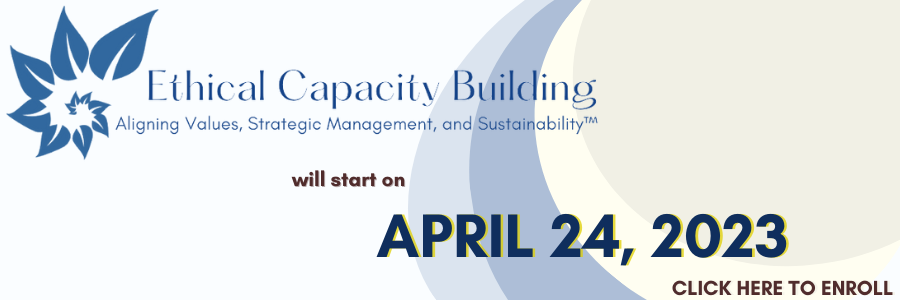Top 3 Lessons from the Collapse of Silicon Valley Bank (SVB) About Nonprofit Cash-Flow and Risk Management
Mar 17, 2023
The Silicon Valley Bank (SVB) collapse reminds us that protecting your organization’s cash reserves extends beyond managing cash-flow. It requires conducting a regular risk analysis of your bank. The values-driven outlined in the ETHOS framework emphasizes that effective financial oversight requires that nonprofit organizations plan well ahead of time for uncertain financial times. Sound fiscal practices, risk-management strategies, and contingency planning will help nonprofits make level-headed decisions in the face of crisis instead of making fear-driven choices that do not reflect their values.
1. Nonprofit Cash Management Should Include Bank-Risk Management
Many limit the parameters of managing cash flow to the following:
-
Creating a realistic and conservative budget and cash-flow assumptions;
-
Considering the impact and timing of grants;
-
Working around the parameters of funding restrictions;
-
Calculating the payroll schedule, fees, insurance costs, and taxes related to payroll;
-
Accounting for the timing of payments and receipts, including anticipating slow funding disbursements, particularly from the government during the summer months when many governments end their fiscal year;
-
Creating a reserve for unexpected emergencies, unfunded start-up costs, unfunded professional development, and the costs of an underfunded mission-critical program;
-
Paying all bills on time to avoid late fees and penalties;
-
Ensuring that your revenue exceeds your deficit;
-
Regularly monitoring your cash-on-hand;
-
Controlling the timing of your expenditures;
-
Regularly comparing budgeted expenses versus real expenses; and
-
Creating a contingency plan in the event of loss of revenue or depletion of cash-reserves.
Although these steps are key to the financial health of any organization, it is also important to regularly monitor the financial health of your bank, the costs associated with banking at that institution, the best way to yield a return on large amounts of cash instead of just leaving it idle, and assess the risk you’re assuming with your bank account cash limits.
2. Monitoring the financial health of your bank:
As we see from the Silicon Valley Bank (SVB) collapse, monitoring the financial health of your bank and whether you are yielding returns on your accounts is essential. The following steps are critical for your financial health to prevent your organization from potentially losing any money above the FICD insurance limit:
- Regularly examine the stability and strength of your bank. There are a couple of ways to do this. First, look at the rating the Federal Deposit Insurance Corporation (FDIC) and the credit rating agencies have assigned your bank. If it is a grade greater than a B+, you can feel confident in the soundness and reliability of your investment. Some use a proprietary formula to determine ratings while others use the CAMELS system (which stands for Capital adequacy, Asset quality, Management, Earnings, Liquidity, and Sensitivity) to assess these financial institutions. It is best to work with a board member, accountant, or financial advisor to best understand the risk you are assuming because the numbers and the legal requirements are very technical.
- Examine your bank’s quarterly and annual reports or go on the FDIC website. In particular, look at the Provision Coverage Ratio (PCR). The percentage of non-current loans compared to total loans. Banks usually set aside a portion of their profits to cover bad loans. A high PCR ratio above 70% typically means the bank is not vulnerable. Also, look at the bank’s deposit growth and available cash. These two measures help you determine if there are enough assets to cover losses.
- If you have cash balances in your bank account that exceed the FDIC-insured limit of $250,000, then you should assess whether you want to diversify your banking institutions. The standard insurance amount is $250,000 per depositor, per insured bank. The FDIC does not insure stocks, bonds, mutual funds, annuities, or any other investment you might purchase from a bank.
- Determine whether you are underutilizing the financial tools at your banking institution(s) and leaving potential earnings on the table by not earning interest. Consider whether it makes sense to put unused cash in restricted accounts with higher interest rates than a savings or interest-bearing checking account. One alternative is a Certificate deposit (CD), which pays higher interest rates than a savings account over a fixed period of time. It is important to remember that you can’t add or remove any money until its maturity date without paying a penalty. This is why before selecting this product, you should analyze the timing of your expenditures and cash-on-hand requirements to ensure you can cover all of your costs. Another option is a Sweep Account. This product automatically transfers amounts that exceed a certain level into a higher interest-earning investment option like a money market fund at the close of each business day. Sweep Accounts can be more flexible with accessing cash immediately, but you have to look at the terms. You should also consider the costs of sweep accounts to see if you will yield enough of a return since many sweep accounts come with brokerage fees.
As always, financial decisions should be transparent. Accordingly, you should vet any potential Conflicts of Interest amongst Board members or anyone on your financial advisory team to avoid being steered to a product that would benefit them personally instead of the organization.
3. The ETHOS Framework Fosters Values-Driven Collaboration for Financial Decisions
The ETHOS framework for decision-making shows us that financial decisions have to be made in conjunction with a team of experts who understand their impact. As you are sifting through the various financial and product options that banks provide, input from board members with financial expertise and other financially savvy professionals (e.g., CFO, lawyers specializing in financial matters, auditors, accountants, financial planners, bankers, etc), will help you to chart a path forward towards robust financial checks and balances.
Regular risk assessments of your banking institutions, credit card use, banking products (e.g., savings, checking accounts, CDs, Cash Sweep accounts, etc.), and investments are critical to fully understand the financial impact, pros, and cons of each financial choice your organization makes. For example, knowledgeable professionals will help you understand the true costs of fees, potential earnings, the benefits of different monitoring strategies, and whether it is safe to temporarily restrict your cash in a CD considering the timing of your expenses.
Remember, when in doubt, consult a professional financial expert for the best decision for your organization instead of relying on Internet advice exclusively. Otherwise, you could be risking the financial health of your organization.
Prepare to transform your nonprofit experience by implementing the ETHOS Framework…
If You Haven’t Already, Please Subscribe
Please subscribe to Third Sector News, which will also provide resources and toolkits for managing real-life situations that those working in the nonprofit field experience. For example, this week, we have included a “Nonprofit Website Toolkit”. Please note, these resources are only available to those that subscribe.
BE UPDATED AND STAY CONNECTED
We hate SPAM. We will never sell your information, for any reason.



